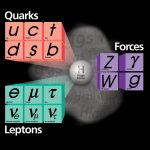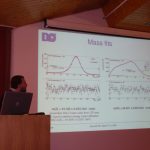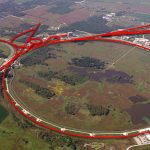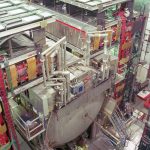Batavia, Ill.—Scientists of the DZero collaboration at the Department of Energy’s Fermi National Accelerator Laboratory have achieved the world’s most precise measurement of the mass of the W boson by a single experiment. Combined with other measurements, the reduced uncertainty of the W boson mass will lead to stricter bounds on the mass of the elusive Higgs boson.
The W boson is a carrier of the weak nuclear force and a key element of the Standard Model of elementary particles and forces. The particle, which is about 85 times heavier than a proton, enables radioactive beta decay and makes the sun shine. The Standard Model also predicts the existence of the Higgs boson, the origin of mass for all elementary particles.
Precision measurements of the W mass provide a window on the Higgs boson and perhaps other not-yet-observed particles. The exact value of the W mass is crucial for calculations that allow scientists to estimate the likely mass of the Higgs boson by studying its subtle quantum effects on the W boson and the top quark, an elementary particle that was discovered at Fermilab in 1995.
Scientists working on the DZero experiment now have measured the mass of the W boson with a precision of 0.05 percent. The exact mass of the particle measured by DZero is 80.401 +/- 0.044 GeV/c2. The collaboration presented its result at the annual conference on Electroweak Interactions and Unified Theories known as Rencontres de Moriond last Sunday.
“This beautiful measurement illustrates the power of the Tevatron as a precision instrument and means that the stress test we have ordered for the Standard Model becomes more stressful and more revealing,” said Fermilab theorist Chris Quigg.
The DZero team determined the W mass by measuring the decay of W bosons to electrons and electron neutrinos. Performing the measurement required calibrating the DZero particle detector with an accuracy around three hundredths of one percent, an arduous task that required several years of effort from a team of scientists including students.
Since its discovery at the European laboratory CERN in 1983, many experiments at Fermilab and CERN have measured the mass of the W boson with steadily increasing precision. Now DZero achieved the best precision by the painstaking analysis of a large data sample delivered by the Tevatron particle collider at Fermilab. The consistency of the DZero result with previous results speaks to the validity of the different calibration and analysis techniques used.
“This is one of the most challenging precision measurements at the Tevatron,” said DZero co-spokesperson Dmitri Denisov, Fermilab “It took many years of efforts from our collaboration to build the 5,500-ton detector, collect and reconstruct the data and then perform the complex analysis to improve our knowledge of this fundamental parameter of the Standard Model.“
The W mass measurement is another major result obtained by the DZero experiment this month. Less than a week ago, the DZero collaboration submitted a paper on the discovery of single top quark production at the Tevatron collider. In the last year, the collaboration has published 46 scientific papers based on measurements made with the DZero particle detector.
- The Standard Model describes the interactions of the fundamental particle of the world around us. Experimental observations agree with the predictions of the Standard Model with high precision. The W boson, the carrier of the electroweak force, is a key element in these predictions. Its mass is a fundamental parameter relevant for many predictions, including the energy emitted by our sun to the mass of the elusive Standard Model Higgs boson, which provides elementary particles with mass. Credit: Fermilab
- Fermilab’s DZero collaboration obtained the world’s most precise W mass value measured by a single experiment and announced its result at the annual conference on Electroweak Interactions and Unified Theories known as Rencontres de Moriond on March 8. Physicist Jan Stark, of the Laboratoire de Physique Subatomique in Grenoble, France, presented the result. Credit: DZero collaboration
- The DZero collaboration comprises about 550 scientists from 18 countries who designed and built the 5,500-ton DZero detector and now collect and reconstruct collision data. They research a wide range of Standard Model topics and search for new subatomic phenomena. Credit: DZero collaboration
- The Fermilab accelerator complex accelerates protons and antiprotons close to the speed of light. The Tevatron produces about ten million proton-antiproton collisions per second, maximizing the chance for discovery. Two experiments, CDF and DZero, search for new subatomic particles and forces unveiled by the collisions.
- The DZero detector records particles emerging from high-energy proton-antiproton collisions produced by the Tevatron. Tracing the particles back to the center of the collision, scientists understand the subatomic processes that take place at the core of proton-antiproton collisions. Scientists search for the tiny fraction of collisions that might have produced a Higgs boson.
Notes for Editors:
DZero is an international experiment of about 550 physicists from 90 institutions in 18 countries. It is supported by the U.S. Department of Energy, the National Science Foundation and a number of international funding agencies.
Fermilab is a national laboratory funded by the Office of Science of the U.S. Department of Energy, operated under contract by Fermi Research Alliance, LLC.
InterAction Collaboration media contacts:
A full list of worldwide InterAction media contacts is available at: http://www.interactions.org/presscontacts/
For more information on the InterAction Collaboration, visit www.interactions.org.








